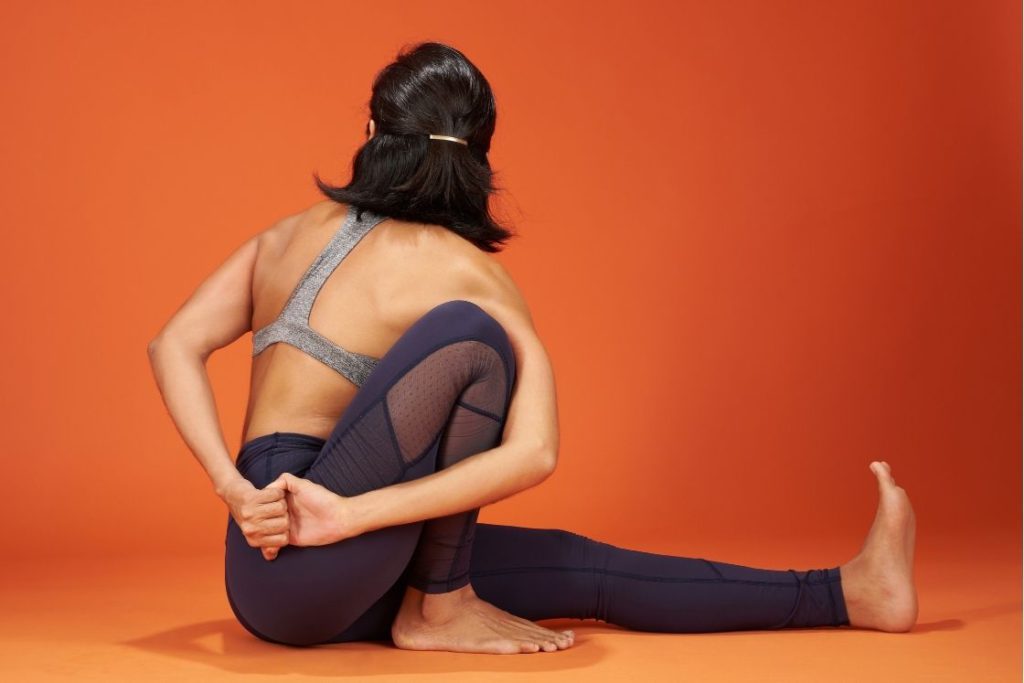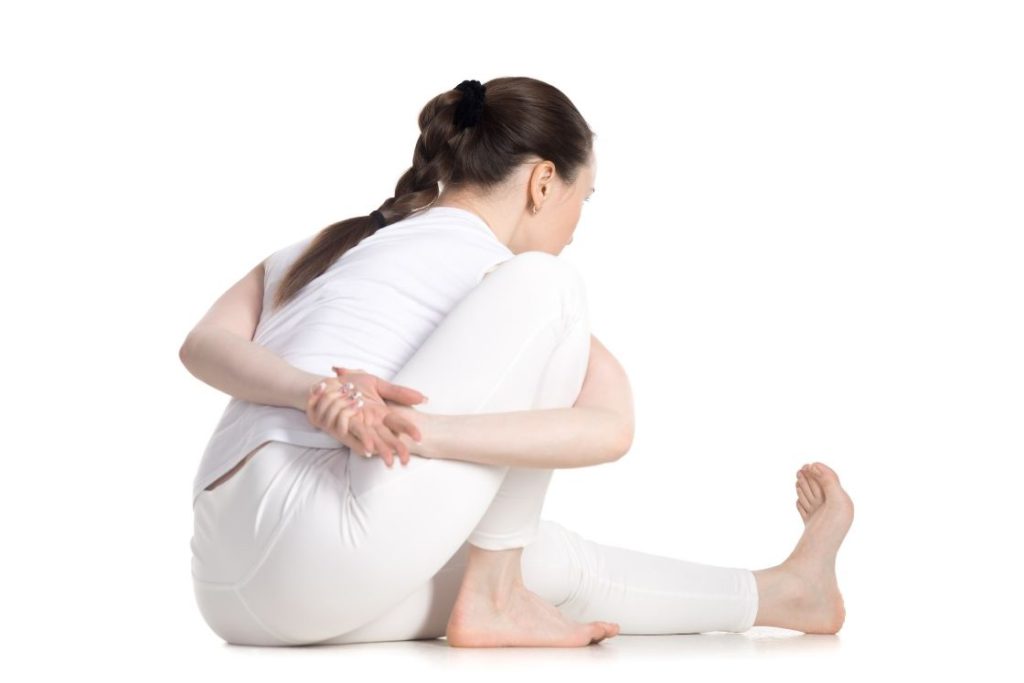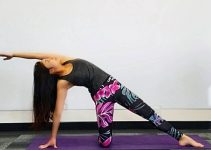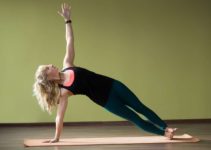
Marichyasana is a mirror pose that contemplates the extent of your flexibility. This posture of the Ashtanga Primary series along with all its variations serves as a body revitalizer.
It is performed sitting on the floor, stretching one leg forward, and bending the other on the knee. The foot of the bent leg is placed on the floor beside the inner edge of the stretched thigh. Both the hands are clasped behind the back with the raised knee locked under the corresponding armpit. This is followed by a forward bend placing the chin on the stretched knee.
The spinal twist and stretch, combined with forward-bending make it a challenging posture. Though the pose sounds simple, however, the intensity of flexibility required makes it an intermediate posture.
It majorly targets the abdominal and back muscles. It is also an intense stretch to strengthen the legs, arms, chest, and hip joints.
Besides toning the entire body and making it supple, it leaves the practitioner energized and stress-free.
Meaning and Interpretation
Marichyasana is named after the great Hindu Sage Marichi, who was the son of Lord Brahma. It is so because Maharishi Marichi only popularized this asana among other yogis.
Etymology and origin
In Sanskrit, “Marichi” refers to “ray of light” and “asana” means “pose”. As the pose is traditionally believed to kindle the inner light and wisdom, hence the name.
It was first described in Krishnamacharya’s Yoga Makaranda, followed by his pupils B.K.S Iyenger and Pattabhi Jois’s teachings.
Marichyasana is also known by the names of Sage Twist Pose, Marichi’s Pose, or One-Legged Seated Spinal Twist Pose.
Practice Guide of Marichyasana

Contraindications
- Do not practice this asana with any injury on the knees, hips, or wrists.
- Pregnant women must avoid this pose after the second month.
- Avoid this pose if you are suffering from migraine.
- People with severe spinal issues must refrain from this pose.
- Patients of asthma or any other respiratory disorder must avoid the pose.
- Women should skip the pose during menstruation.
- Do not try marichyasana with an upset stomach, viz. diarrhea, or dysentery.
Preparatory Poses
It is inevitable to open the hip flexors and have flexible arms and back muscles to practice marichyasana correctly.
Practice the following poses to enhance the elasticity of the body before stepping into marichyasana:
- Deer Pose (Mrigiasana)
- Side Twist Pose (Vakrasana)
- Seated Torso Circles (Kundalini Circles)
- Half Lord Of the Fish Pose (Ardha Matsyendrasana)
- Head to Knee Pose (Janu Sirsasana)
- Half Bound Lotus Forward Fold (Ardha Baddha Padma Paschimottanasana)
How To Do Marichyasana (Steps)

- Begin with sitting in dandasana.
- Bend the left knee to place the left foot beside the inner edge of the right thigh.
- Place the left heel closer to the perineum.
- Draw the left shoulder forward in a way that the left armpit touches the left shin.
- Wrap the left arm around the left shin and thigh. Now bend the elbow to reach the back from the left forearm at your waist.
- Raise your right hand to bring the right arm around the back and clasp the left wrist.
- Twisting the spine turn to your left and keep your eyes towards the outstretched right big toe.
- Hold this pose for a few deep breaths, then come back to the center.
- Exhale and bend forward to rest the forehead, nose, then lips, followed by chin on the right knee.
- Keep your shoulders parallel to the floor and keep breathing.
- Hold this final pose for 30 seconds.
- Inhale, lift your head from the right knee, release the hands, and extend the left leg forward.
- Relax in dandasana and then repeat the same on the other side.
Precautions
Be mindful about the following moves while practicing marichyasana to prevent any possible injury:
- While bending forward do not lose the integrity of the back.
- Keep your torso extended forward without letting the tummy lose.
- Do not bend or lift the relaxed leg while performing the pose.
Beginner’s Tips
- Beginners find clasping the wrist behind the back challenging. They must try either grabbing the palms or fingers of the alternate hand.
- It might be beyond your flexibility to bind the hands behind the back. Thus, first indulge in the asana by holding the big toe of the stretched leg with an alternate hand while bending forward.
Follow-up Poses
Performing marichyasana exerts pressure on the lower back and abdominal muscles. Besides these the arms and legs are kept extended, therefore the body requires cooling by the following counterposes:
- Staff Pose Hands Back Knees Bent (Dandasana Hands Back Knees Bent)
- Staff Pose Hands Back (Dandasana Hands Back)
- Bridge Pose (Setu bandh asana)
- Wind Release Pose (Pawanmuktasana)
Props and Modifications
- Folded blanket – Place a folded blanket under your hip and then proceed with the twist and forward fold for marichyasana. The increased level of hip helps in increasing back and hamstrings flexibility. It also helps in softening the groins and eases the rotation from the buttocks to perform the twist.
- Yoga strap – After bending the left leg from dandasana hold a yoga strap or belt in the left hand. Wrap the left arm from inside of the left leg around the shin reaching the back. Draw the right hand to the back and hold the other end of the strap around the back.
Variations
1. Marichyasana A
- Sit in dandasana, then bend your left knee to put the left foot on the right thigh’s root.
- Flex the right knee to place the right foot on the floor.
- Draw the right shoulder forward to bring the right armpit over the right knee.
- Wrap the right forearm around the right shin and thigh followed by bending the elbow to reach the back by the right hand.
- Swing the left arm around the back and clasp the right wrist with the left hand.
- Breath deeply holding the pose.
- Exhale leaning forward and rest the head on the bent left knee.
- Extend the neck to rest the chin on the left knee. Repeat it 3-4 times with inhalation and exhalation coming up and going down respectively.
- Inhale raising the head, releasing the arms and legs, then, relax. Repeat on the other side.
2. Marichyasana B
- From dandasana, bend the left knee to placing the left foot beside the right thigh.
- Keep the left heel pressed against the perineum.
- Exhale twisting the spine at 90° angle to the left to bring the chest beyond the left thigh.
- Bring the right arm over the left thigh and right shoulder beyond the left knee.
- Extend the right arm forward by further twisting the spine to the left.
- Stay there and take two breaths.
- Exhale curling the right arm around the left knee.
- Flexing the right elbow, reach the back of the waist with the right hand.
- Exhale, draw the left arm behind the back to clasp the right wrist by the left hand.
- Turn the neck to either look behind the right shoulder or gaze towards the toes of the extended leg.
3. Marichyasana C
- Sit in dandasana.
- Bend the right knee to place the right foot at the left thigh’s root.
- Bend the left knee placing the left heel pressed against the perineum.
- Exhale turning the spine about 90° to the left.
- Place the right shoulder beyond the left knee and extend the right arm forward further twisting the spine.
- Inhale, then exhale curling the right arm around the left knee.
- Bend the right elbow to place the right hand at the back of the waist.
- Keeping the left knee locked in the right armpit, take a breath.
- Exhale deeply and draw the left arm behind the back clasping the right hand.
- Stretch the chest and extend the spine up. Stay there for 30 seconds and keep breathing.
Therapeutic Applications
- Marichyasana cures flatulence, constipation, and indigestion.
- It is known for its relieving effects on the lower backache.
- Due to the twist, the pancreas is massaged and squeezed, it proves the pose therapeutic in curing diabetes.
- This pose makes the womb stronger and helps the pregnant woman to carry the fetus safely.
- It alleviates menstrual pain and discomfort.
- It stretches the buttocks and the thigh muscles intensely. Therefore, relieves the sciatica pain as well as cures sciatica.
- The forward bend involved in the pose helps in stretching the spine all the way to the crown. It brings fresh oxygen to the brain relieving mental tension, fatigue, and stress.
Marichyasana Benefits
1. Strengthens the legs and hips
While performing marichyasana the calves, hamstrings, knees, and ankles are stretched. Along with the legs, the buttocks are engaged that stimulates the psoas muscles. It strengthens the hip flexors and leg muscles.
2. Improves spine flexibility
The entire spine is twisted laterally and stretched intensely while bending forward. It expands the vertebrae and enhances the supply of blood to the back muscle. Therefore marichyasana strengthens the spine and enhances spine flexibility.
3. Opens the chest and shoulders
This asana is performed expanding the chest and stretching the shoulders. This increases the lung’s volume and improves breathing capacity. This enhances the efficiency of the respiratory system.
4. Improves blood circulation
The opening of the chest also stimulates the heart. It regulates the flow of blood to the entire body. Hence the pose is also beneficial to improve the circulatory system.
5. Regulates metabolism
In the final pose, the neck is stretched as the chin is placed on the knee. It activates the thyroid gland and improves the secretion of thyroid hormones. This eventually helps to maintain the overall metabolism.
6. Facilitates digestion
Marichyasana involves a forward bend that compresses the abdominal muscles. It stimulates the internal organs, squeezes the stomach, intestine, liver, and pancreas. This regulates the secretion of the digestive juice and hormones and helps in better digestion.
7. Activates the Manipura chakra
Due to the stimulation of the abdomen, the Manipura chakra is activated. It develops self-confidence, decisiveness, and happiness in the practitioner.
Conclusion
Including marichyasana and its variations into regular practice brings several health benefits. The pose revitalizes the human body anatomically as well as tones the body shaping it beautifully.




